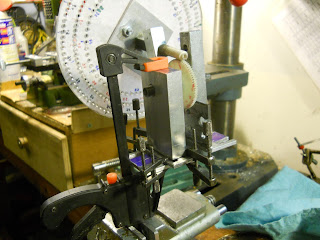As I may have said, I got tired of cutting gears. This requires so much concentration that I wanted a vacation. So I have undertaken two new projects. One is to install my (Taiwanese) Emmert vise on the woodworking workbench. The other, which goes back a while, is to make mutipoint clock gear cutters. The first project is a future post. This post deals with making clock wheel (gear) cutters.
Now gears come in two major flavors. One is the involute form found every mechanical contraption that uses gears. The other is the cycloidal form, found almost exclusively in clocks. The involutes are better at transmitting power. The cycloidals have less friction, and so are favored in clocks.
Gears of any flavor are cut by (guess what) cutters. You can buy these things. They are expensive. Not only that, and mainly, none of them will fit my Proxxon micromill. So I am making my own. The main requirement is that I have to fit them to Cecil B. de Mille, my mill.
In making these cutters I am basically following Dean's writeup. All cutters need relief. Just like a kitchen knife. It is difficult to slice anything unless your knife is curved. That's relief. The edge does not drag once the nain part goes through. If you really want to make cutters, you must read this writeup.
The way we do this is to build an eccentric arbor. This provides the relief.
But first we have to turn a wheel blank. I started out with the idea of turning it to fit the Proxxon 3mm collet.
Nice idea. But for various reasons it did not work, so plan B. We will make disks, and turn them on an eccentric arbor, but my eccentric arbor is much smaller an Dean's device. An eccentric arbor is a cylinder, but with the center (a 6-32 screw) offset from the true center by 4mm. In the real center is a broken drill bit about 2mm in diameter. Very small. It is an anti-rotation and indexing pin.
Next step is to drill four holes in a cutter blank. The holes form a square 4mm to a side. Dean & co. suggest making a drilling jig. I did the first one on the mill. Afterward I did a proper drilling jig, because drilling holes on the mill by plunging is like dentistry. Painful. I used my handy setup plate in the mill vise. You can barely see the blank.
So with four holes in the blank, pick one, put the center hole into the screw, put one hole in the pin, and you have the setup below. It looks off-center, does it not? It is. It is supposed to be. When we put the whole megilla into the lathe, we will turn sort of a square with round sides.
When you are doing this you have to be very careful with the depth of cut. I experimented with setting up dial indicators to do this.
Impossible. They don't make them small enough, and I have no room to fit everything in. So I made a stop. It took a day, well worth it.
The stop is a dovetail that fits the ways of the Taig, an has a screw for fine adjustment, unfortunately a 6-32 screw because it is difficult to find metric screws this small (about 5mm) this small in Alaska.
Next job is to make a radius forming tool. This tool will form the radius (which has to be exact). I had not reckoned with Lowe's 3/4" "mild steel." It is made out of supermanium. I think Lowe's supplier slipped up that day, and threw in a round bar made out of Titanium SuperSteel, because I made this tool out of Dremel shanks, which I know can be hardened.
Now we mount this in the middle of a square .25" bar and mill off exactly half of the tool, leaving a very sharp edge. We did this on the mill. Note the gear sitting to the left. It's the one I haven't completed. We use this tool to form the radii on the cutter. Then we use this tool to cut the radii. The first few radius tools I made were eaten up by the Lowe's Supermanium. I finally resorted to a broken Proxxon endmill. Teutonic technology proved superior to supermanium. I got a radius, Crude, but good enough for practice purposes. Now let's cut off the waste. Dean et al. use a slitting saw, but I used a Dremel abrasive cutoff disk mounted on the mill.
This has the great advantage. You don't have to grind the cutter; the cutoff does it for you. My finished cutter has two good teeth on it, the others were ruined by stupid mistakes.
I have learned a lot from this. I think I can make my own cutters now. More to come. Pic of cutter bit blurry, new camera. Will improve.
See through the trees
4 weeks ago
























































